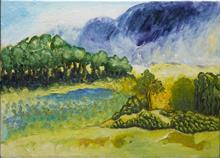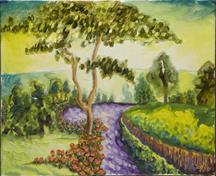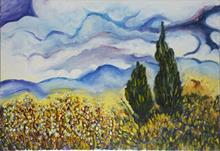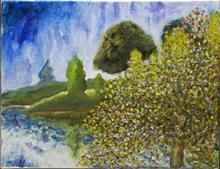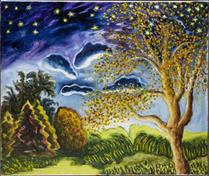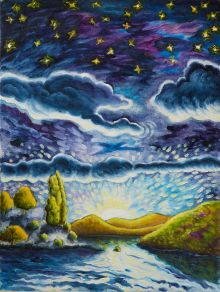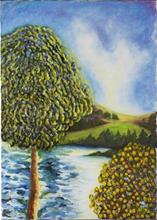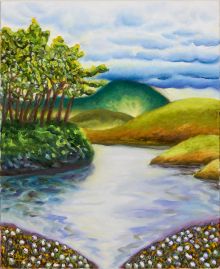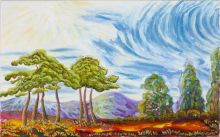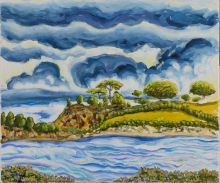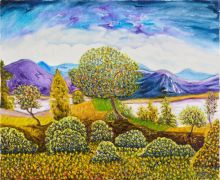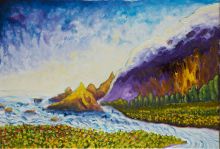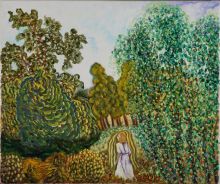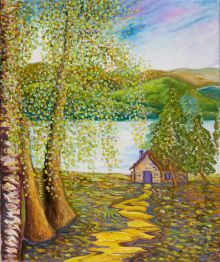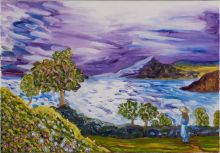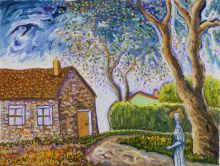The breeze of the stars (2022)
In the footsteps of Van Gogh
Perhaps it is not correct to say that Van Gogh is the father of modern
painting, but it is of one of its paths, the spiritual one, in my opinion. Although it
would not be correct to say spiritual, since all art is spiritual, being able to be left
in more specifically spiritual, with certain characteristics that define it as such,
which does not mean that he paints spiritual themes, but rather because of the
spiritual way of proceeding when carrying out the painting. construction site.
The family vein already comes to him, his father was a Protestant pastor
and he studied and also prepared himself to be one, leading him to work as a
preacher among the miners. Later, already dedicated to art, in Nuenen, we can
see in the work "the potato eaters" a manifestation of that spirit.
Later, in Arles, he would complete his spirituality with the Zen coming
from the Japanese prints that had so impressed the Impressionists at the
Universal Exposition in Paris, but no one would buy so many or set out to follow
the path of art and life in that very sense. totally like Vincent. Thus, his transfer
to Arles would consist of a search for the rising sun of the East and a study and
practice of Japanese Zen art, based on the spirit and technique of Japanese
artists such as Ukiyo-e, Hiroshige Hokusai or Keisai Eisein.
The latter, Van Gogh's close link with Japanese painting, surprised me a
lot, since I had also been involved with Zen painting for more than a decade,
although more with the ancient Chinese artists of Zen and Tao.
What a coincidence, when even before I realized this it could be said that
he had been my main teacher of modern art. And this one who had gone for
Zen meets Van Gogh again on the way.
Despite my style being so different, he is the modern artist who inspires
and teaches me the most, and whose lineage I feel I continue with.
At the beginning of the 90s, I began to feel in art that something that
goes beyond logical thought, from which a value in mystery stemmed from
detachment and detachment. Which would lead to the strength of the spirit
through the deployment of being-ethical along the way.
In January 2021, finding myself in a place on the Asturian coast, on the
other side of when in 1989 the seascape burst inside me, coming to a shudder
with undoing, becoming light, color, shape, energy; the pulse of Creation behind
the elements. And feeling such energy comes to me: “so this is impressionism”.
More than 30 years later, in that same place, to one side I was
contemplating the landscape of the last work in which I was working, of
sensitivity, exquisite, precious, in artistic detail.
On the other side, breaking out the spirit, a mysterious force.
Artistic sensibility and spirit, he felt that he should work in a suitable and
harmonious combination of both aspects.
It had to accommodate courage, not confusing it with haste, much less
with recklessness. Not holding back the spirit, allowing it to emerge when it is
ready after the precise catharsis. The spirit blowing into the heart.
In Van Gogh the spirit breaks out.
Capturing the Spirit of Truth like him, like his disciple. His imitation of
Jesus, his path in the Transcendent. The colors of the heart
Vincent was tremendous. Of course I do not intend to compare myself
with him, only that I feel very close to his way of being, although of a different
character. And perhaps I can contribute a grain of sand in helping to guide
future generations in a modern art of the spirit, maintaining its continuity (it
would be a shame if this path were lost), starting from the work of our main
teacher, Vincent Van Gogh , in one of the ways of modern art.
In Arles he wanted to form a community of artists as monks in a
monastery. When he collided with the reality of the impossibility of realizing
such a dream, something was torn deeply inside him. And that, together with
the confinement in the sanatorium, was probably the main cause of the
aggravation of the disease, since the dates of such events coincide. To which,
of course, must be added the continuous socioeconomic oppression, contempt
and misunderstanding of his work, so common in so many artists, who would do
better to accept, understand and love the spirit of poverty and not be carried
away by the banalities of the world. world.
The strange thing is that some time later, already in Saint-Rémy, he
seemed to be recovering quite a bit. Theo recounts in a letter to his brother at
that time: “…color has a strength that you had not reached until now… But how
dare you go to the most extreme limits where vertigo inevitably has to assault
us”. So why did he commit suicide? Or was it not a suicide? There are
indications that it was probably not a suicide.
“It is not without appeal to think that the Greeks, the old Dutch masters,
and the Japanese continued to cultivate their famous schools in other
constellations,” he says in letter 511. “Where are Newton, Copernicus, Galileo,
Jesus, Buddha, Confucius or Socrates?" asked the astronomer Camille
Flammarion at the same time, to conclude with Van Gogh: "These stars still
shine and exist in other spheres, they continue in other worlds the work they
have interrupted on earth." Van Gogh starts spontaneously from this idea and
explains the intention of his self-portrait (Paris, spring 1887. The Art Institute of
Chicago): "I conceived this portrait as a Buddhist monk, a simple worshiper of
the eternal Buddha", letter 545.*
"The inhalation of the air,
the song of the sweet philomena,
the soto and his grace
in the serene night,
with a flame that consumes and is painless.”**
*Page 384, Van Gogh. Complete pictorial work. Ingo F. Walter & Rainer Metzger.
** Verse of the "Spiritual Song" of San Juan de la Cruz.
